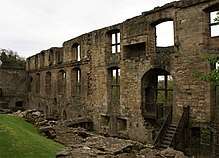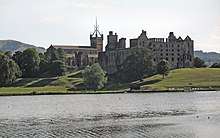Ellen More
Ellen or Elen More (floruit circa 1500-1535) was an African servant at the Scottish court.

.jpg)

Career
Ellen More was employed in Edinburgh Castle in the household of Lady Margaret, the daughter of James IV of Scotland and his mistress Margaret Drummond.[1] Ellen More was later an attendant of Margaret Tudor at Linlithgow Palace.[2]
The name "More" recorded in the Scottish accounts seems to be word "moor", meaning an African person. The reign of James IV (1488 to 1513) coincided with the era of Portuguese exploration which established firm contact between Europe and Africa. James licensed Scottish privateers like Andrew Barton to attack Portuguese shipping.[3] This may have provided a potential route for African people to reach Scotland, although there is no direct evidence of this.[4] The accounts of the Treasurer of Scotland record the arrival and employment of Africans at the court of James IV.[5]
A merchant or captain William Wod received a reward from the king for bringing African people to the court in 1504 accompanied by a Portuguese man. James and Margaret Tudor were at Dunfermline Palace and during a suspected outbreak of plague, the women, called "More lasses", were sent to Edinburgh on 26 November 1504. The accounts record that a woman "tursit" the "More lasses" from Dunfermline, a word that usually means the packing and transport of household goods with cord but can also mean the transport of people.[6] At first the four Africans, recorded as "Ethiopians", were lodged in the house of an Edinburgh merchant called James Hommill.[7] One "More las" was christened on 11 December 1504, and probably given a new name.[8] This record may refer to the arrival of Ellen and her sister Margaret. Ellen and Margaret seem to be the two "More lassis" at Edinburgh Castle who attended Lady Margaret and were bought shoes.[9] In 1506 they were both given gowns of russet cloth with velvet bands, with red skirts or kirtles. In 1507 they, and another girl in the castle, Marjory Lindsay, were given red skirts with green ribbons.[10]
In later years they joined the court of Margaret Tudor and were bought clothes, and given New Year's day gifts, comparable to those given to the queen's English lady in waiting, Mistress Agnes Musgrave. Ellen is known to have worked for the queen at Linlithgow Palace.[11] This is an example from the accounts of a New Year gift of money, five French gold crowns worth £3-10s Scots, given to Ellen More on 1 January 1512; "Item, to Elene Moire, v Franch crounis, iij li x s."[12] She had been given her livery clothes, an allowance of clothing given to many royal servants in the days before Christmas, on 15 December 1511. This included a gown made of "Rissillis broun" (russet cloth from Rijsel or Lille) trimmed with velvet, with yellow taffeta sleeves, a velvet hood, and skirt of English brown or russet woollen cloth with a crimson hem.[13] Margaret More is mentioned less often in the accounts, but she was at Linlithgow Palace in April 1512, when James V of Scotland was born.[14]
The king's daughter, Lady Margaret Stewart married John Gordon, Lord Gordon and then Sir John Drummond of Innerpeffray.[15] No further details of the lives of Ellen and Margaret More are known for certain.
William Dunbar wrote a poem for the court of James IV with the title Of Ane Blak-Moir which describes the appearance of a black woman involved in a tournament in unflattering terms.[16] James IV staged two elaborate tournaments called "The justing of the wyld knicht for the blak lady", held in June 1507 and again in May 1508. The part of the "Black Lady" was played by a woman of the court. It is not clear if William Dunbar's poem was connected to these events, or that Ellen More played the part of the Black Lady in the tournaments, although the identity of Ellen, or Elen More, is discussed in scholarship as the subject of Dunbar's poem, the woman named in the accounts, and the actor in the tournaments.[17]
The Black Lady Tournaments
The expenditure on these lavish events, imitating the "round table of King Arthur of England", was recorded in the Lord High Treasurer's accounts.[18] The invitation to the tournament sent to France was illuminated with gold leaf.[19] It was issued by the Marchmont Herald on behalf of the 'Chevalier Sauvage à la Dame Noire', the Wild Knight to the Black Lady, and gave details of the events to be held at Edinburgh.[20] The Black Lady's gown was made from Flanders damask figured with gold flowers, bordered with yellow and green taffeta, with outer sleeves of black gauze, and inner sleeves and gloves of black leather, and she wore a drape of the same black gauze about her shoulders and arms. In 1508 the costume was renewed with a green woollen skirt, and new black leather sleeves and gloves.[21] William Ogilvy and Alexander Elphinstone, possibly Alexander Elphinstone, 1st Lord Elphinstone, dressed in white damask as the "Squires of the Black Lady" and escorted her from Edinburgh Castle to the field of the tournament.[22] Antoine d'Arces was the "White Knight". James IV himself played the part of the Wild or Savage Knight.[23] At the end of the three-day event, at the concluding banquet, a cloud descended from the roof of the Hall and swept away the Black Lady.[24]
Africans represented in court drama
Later Stewart court festivities and drama with African actors and actors portraying Africans, include; the Entry of Anne of Denmark to Edinburgh (1590), the baptism of Prince Henry (1594), and The Masque of Blackness (1605).[25] At the court of Edward VI of England actors in masques were dressed as "Mores" with long black velvet gloves reaching above the elbow, with bells attached to costumes made from goat's skins.[26] A contemporary description of the 1590 event distinguished between townspeople who had blackened their faces, and "an absolutely real and native blackamoor."[27]
External links
- Minjie Su, 'Elen More: The Moorish Lass in James IV’s Court', Medievalists.net.
- Mairi Cowan, 'Moors at the Court of James IV, King of Scots', Medievalists.net.
- Bess Rhodes, Edinburgh Castle Research: The Tournaments (Historic Environment Scotland, 2019).
- Lesley Mickel, 'Blackness and Wildness: James IV and Highland Cultural Identity'.
- Arkady Hodge, Edinburgh Castle Research: The Medieval Documents (Historic Environment Scotland, 2019).
- 'The King’s Daughter and the "Moorish Lassies"', Historic Environment Scotland blog.
References
- Mary E. Robbins, 'Black Africans at the Court of James IV', Review of Scottish Culture, 12 (1999), pp. 34–45: Accounts of the Lord High Treasurer of Scotland, vol. 3 (Edinburgh, 1901), pp. lxxxv, 182.
- Accounts of the Lord High Treasurer of Scotland, vol. 4 (Edinburgh, 1902), pp. 232, 324, 404, 434: Miranda Kaufmann, Black Tudors (London, 2017), pp. 17-18: Sue Niebrzydowski, 'The Sultana and her Sisters: Black Women in the British Isles before 1530', Women's History Review, 10:2 (2001), pp. 187-210, 201-205: Imtiaz Habib, Black Lives in the English Archives, 1500-1677: Imprints of the Invisible (Ashgate, 2008), pp. 31-7, 292-3.
- Norman Macdougall, James IV (Tuckwell: East Linton, 1997), p. 239.
- The privateer connection was suggested by Patrick Fraser Tytler, History of Scotland, vol. 5 (Edinburgh, 1834), pp. 43-4.
- George Burnett, Exchequer Rolls of Scotland: 1502-1507, vol. 12 (Edinburgh, 1889), pp. 374-5 (Latin).
- Accounts of the Lord High Treasurer of Scotland, vol. 2 (Edinburgh, 1900), pp. 465, 468: 'Turs, v. 3', Dictionary of the Scots Language: Dictionar o the Scots Leid.
- George Burnett, Exchequer Rolls of Scotland: 1502-1507, vol. 12 (Edinburgh, 1889), pp. 374-5 (Latin), the Africans were lodged with Hommill "extra domicilium", indicating in the usual manner of the accounts that they were members of the royal household staying elsewhere.
- Accounts of the Lord High Treasurer, vol. 2 (Edinburgh, 1900), pp. cx, 465, 468, 469, 470: Accounts of the Lord High Treasurer, vol. 3 (Edinburgh, 1901), p. 148: Exchequer Rolls, vol. 12 (Edinburgh, 1889), pp. 374-5: Habib, Black Lives, p. 31.
- Laura E. Walkling and Mairi Cowan, 'A 'gret cradil of stait': Growing Up with the Court of James IV', Janay Nugent & Elizabeth Ewan, Children and Youth in Premodern Scotland (Boydell, 2015), pp. 15-30.
- Accounts of the Lord High Treasurer of Scotland, vol. 3 (Edinburgh, 1901), lxxxv, 114, 155, 172, 175, 310-11, 321-2, 336, 361, 370-1, 387: Accounts of the Lord High Treasurer, vol. 4 (Edinburgh, 1902), 51, 59, 61-2, 82, 100, 116.
- Accounts of the Lord High Treasurer, vol. 4 (Edinburgh, 1902), pp. 339, 324, 401, 404.
- Accounts of the Lord High Treasurer of Scotland, vol. 4 (Edinburgh, 1902), p. 324.
- Accounts of the Lord High Treasurer of Scotland, vol. 4 (Edinburgh, 1902), p. 232.
- Accounts of the Lord High Treasurer of Scotland, vol. 4 (Edinburgh, 1902), p. 339.
- David Malcolm, A Genealogical Memoir of the Most Noble and Ancient House of Drummond and of the Several Branches That Have Sprung From it (Edinburgh, 1808), p. 78.
- W. A. Craigie, Maitland Folio Manuscript, vol. 1 (Scottish Text Society: Edinburgh, 1919), pp. 416-7: John Small, The Poems of William Dunbar, vol. 2 (Scottish Text Society: Edinburgh, 1893), p. 201: Kim Hall, Things of Darkness: Economies of Race and Gender in Early Modern England (Cornell, 1995), p. 271.
- Jane E. A. Dawson, Scotland Re-formed (Edinburgh University Press, 2007), pp. 79-81: Bernadette Andrea, The Lives of Girls and Women from the Islamic World in Early Modern British Literature and Culture (Toronto, 2017), pp. 22-26.
- Louise Olga Fradenburg, City, Marriage, Tournament: Arts of Rule in Late Medieval Scotland (Wisconsin, 1991), pp. 233-4: Thomas Thomson, The History of Scotland, by John Lesley Bishop of Ross (Edinburgh, 1830), p. 78.
- Accounts of the Lord High Treasurer of Scotland, vol.3 (1901), 365
- Marcus Vulson de la Colombière, La Science Heroique (Paris 1644), pp. 453-457.
- James Balfour Paul, Accounts of the Lord High Treasurer of Scotland, vol. 3 (Edinburgh, 1901), p. 259: Accounts of the Lord High Treasurer of Scotland, vol. 4 (Edinburgh, 1902), p. 64.
- James Balfour Paul, Accounts of the Lord High Treasurer of Scotland, vol. 3 (Edinburgh, 1901), pp. xlix, 258-259.
- Katie Stevenson, Chivalry and Knighthood in Scotland, 1424-1513 (Boydell: Woodbridge, 2006), pp. 94-7.
- Lesley Mickel, 'Our Hielandmen': Scots in Court Entertainments at home and abroad 1507 –1616', Renaissance Studies, 33:2 (April, 2019), pp. 185-203 at p. 202: Aeneas Mackay, Historie and Cronicles of Scotland, by Robert Lindesay of Pitscottie, vol. 1 (STS: Edinburgh, 1899), p. 244.
- Bernadette Andrea, The Lives of Girls and Women from the Islamic World in Early Modern British Literature and Culture (Toronto, 2017), pp. 106-12.
- Virginia Mason Vaughan, Performing Blackness on English Stages, 1500-1800 (Cambridge, 2005), pp. 27-8: Alfred John Kempe, Loseley Manuscripts (London, 1836), p. 79-80
- David Stevenson, Scotland's Last Royal Wedding (Edinburgh, 1997), p. 109, the original Danish phrase was "men en ret naturlig og inföd Morian var des Anförer."